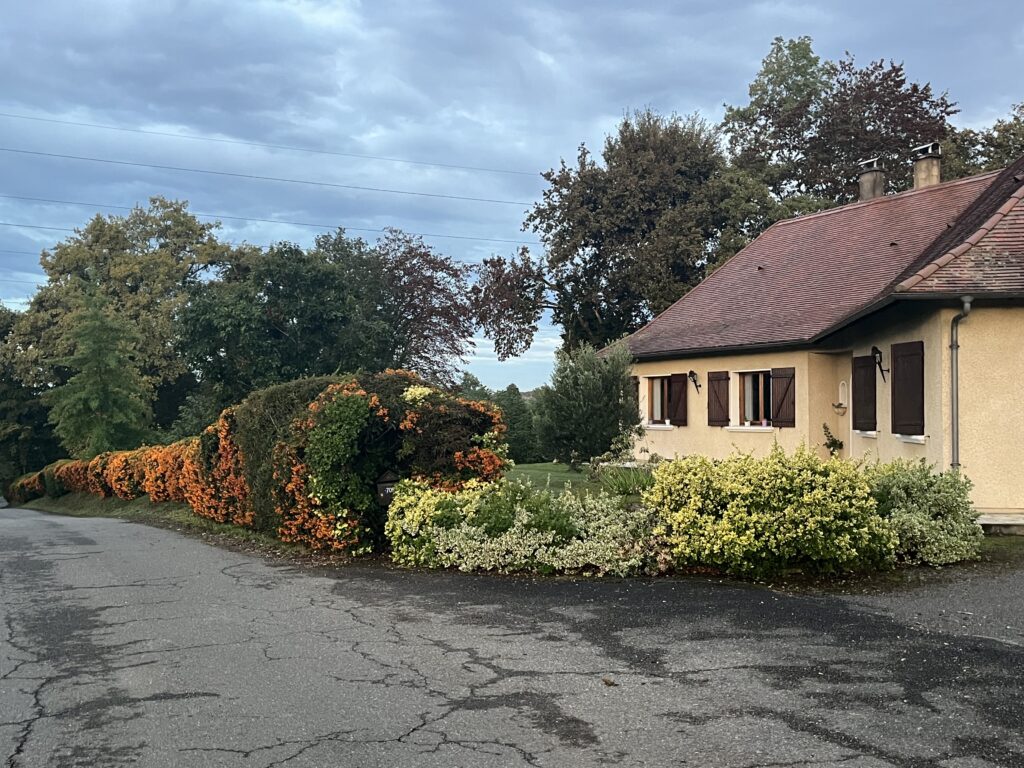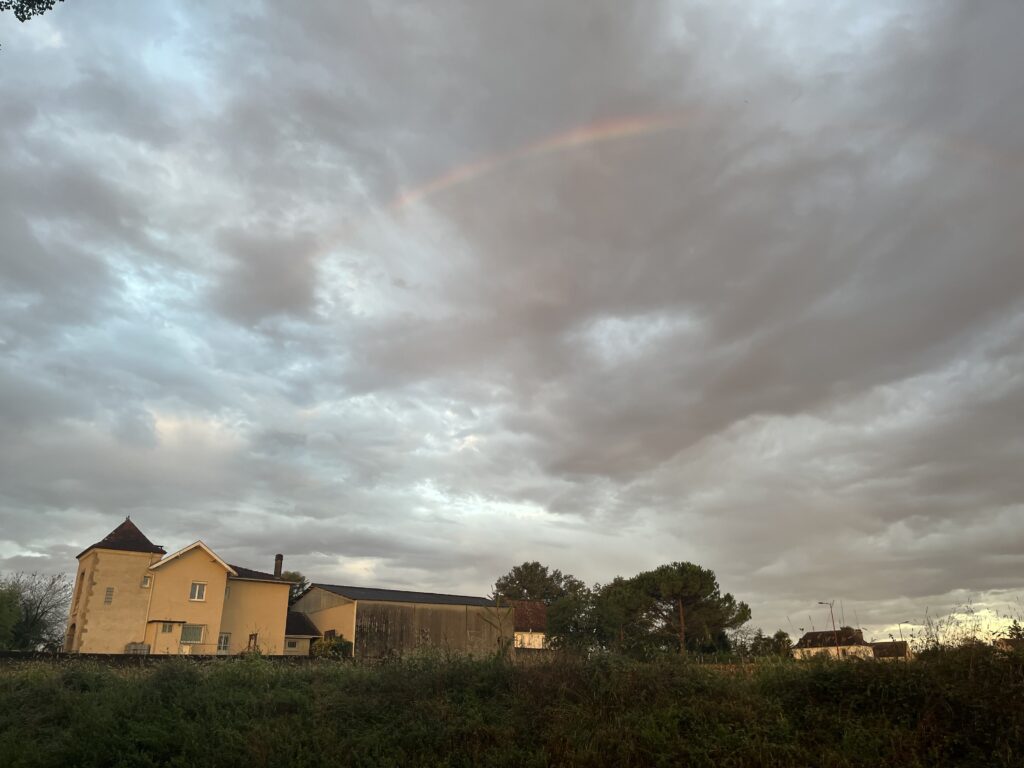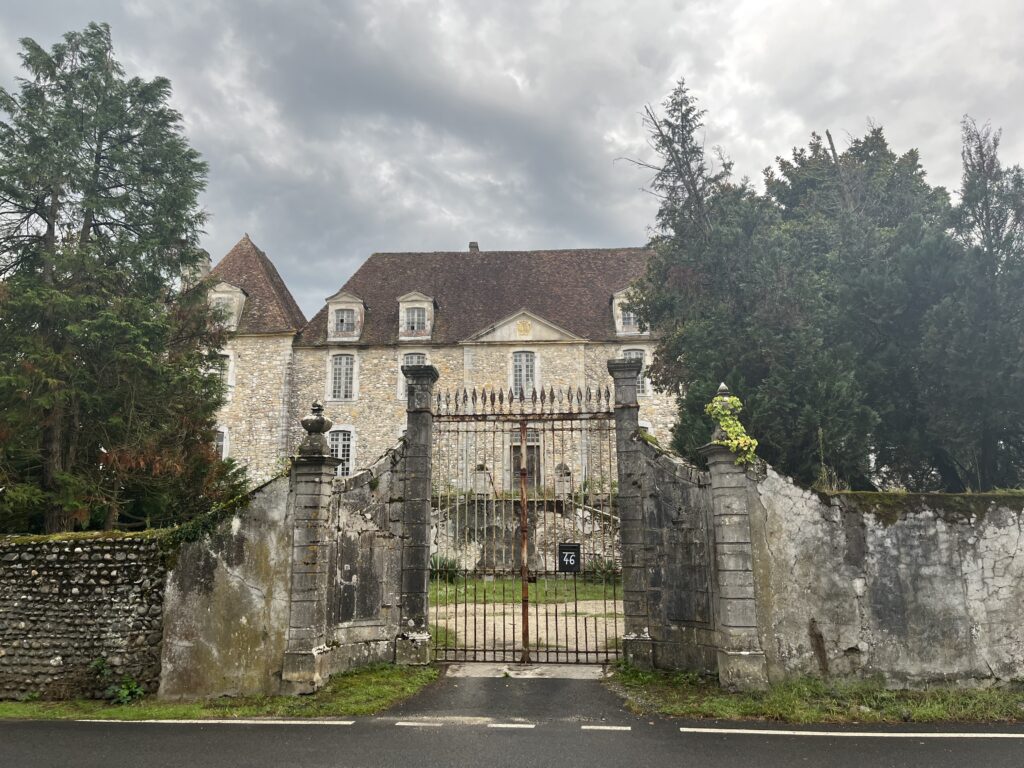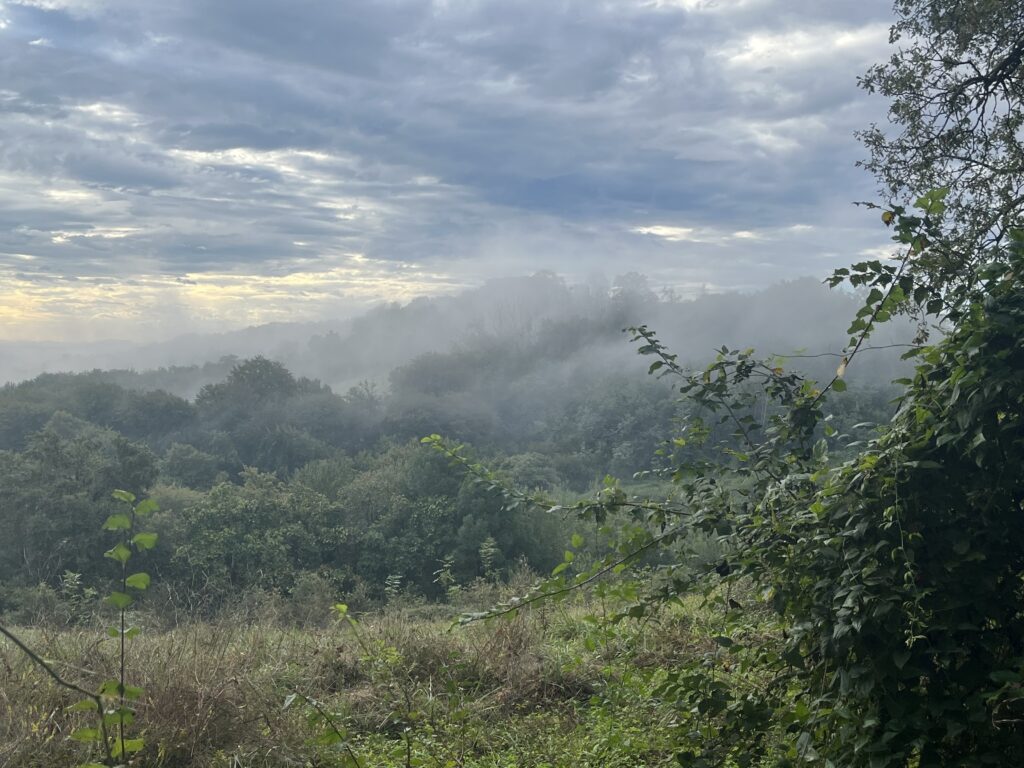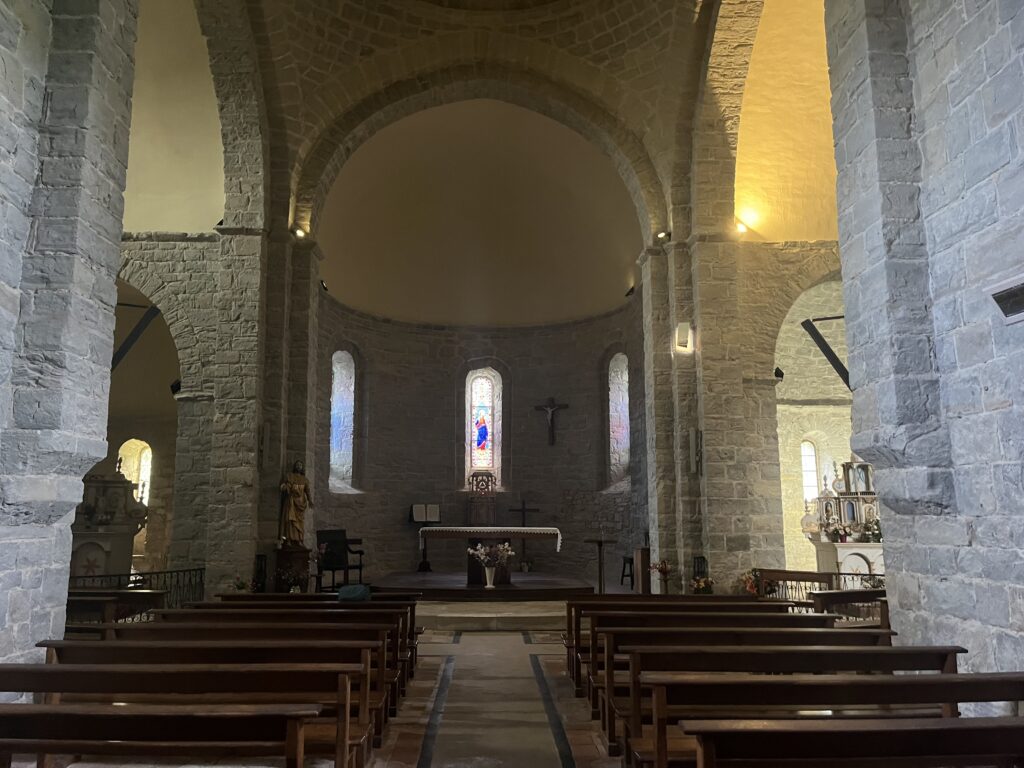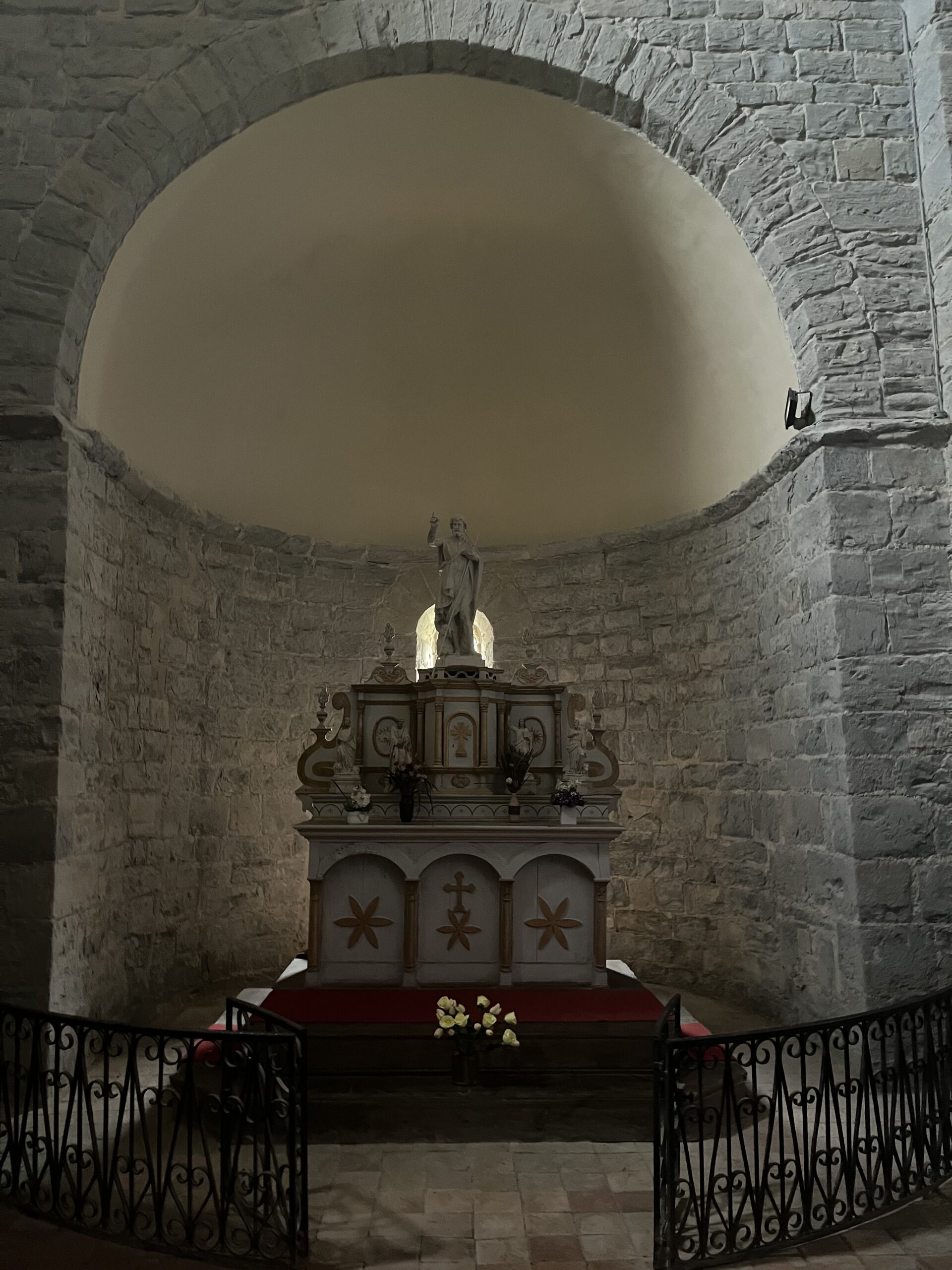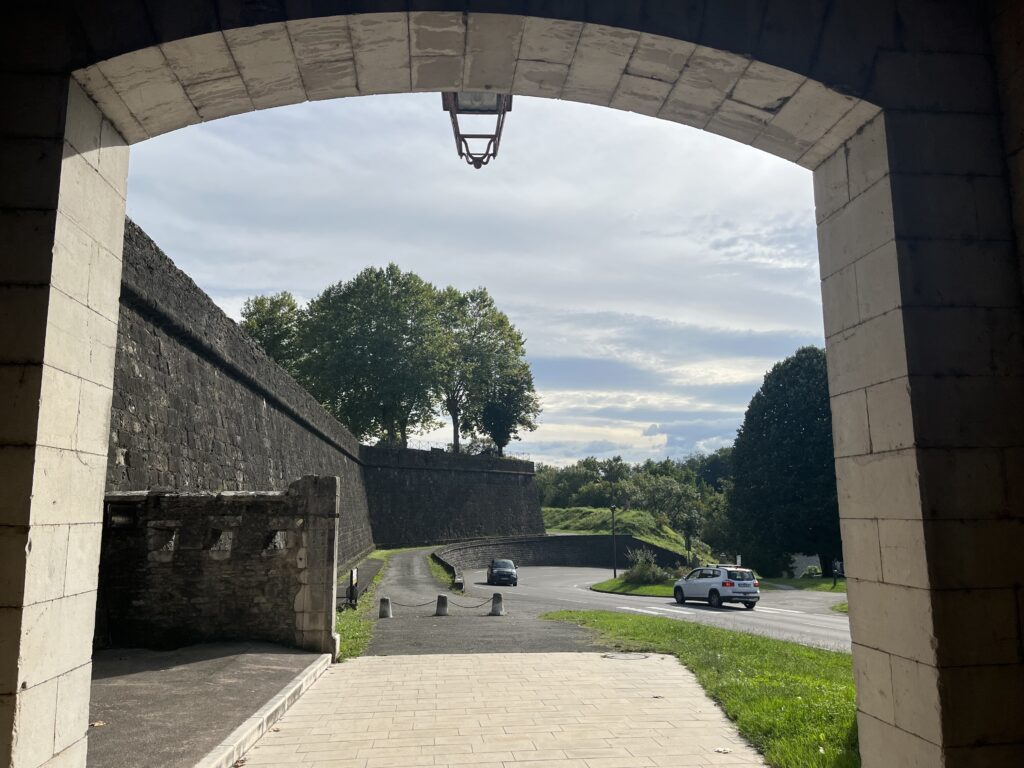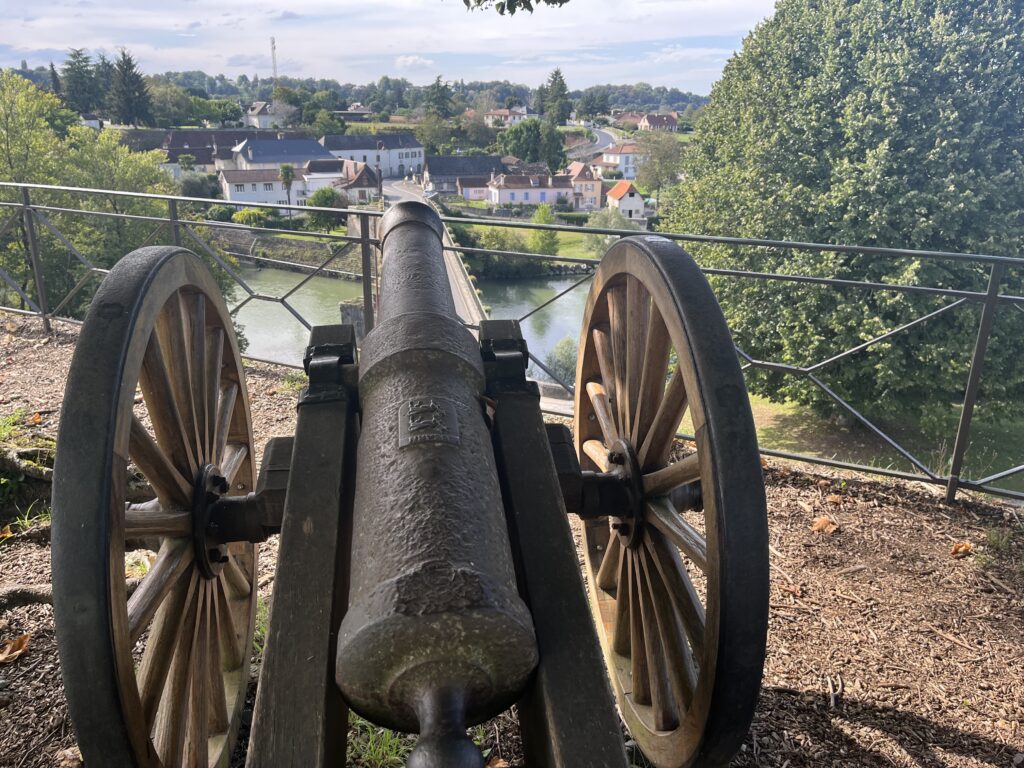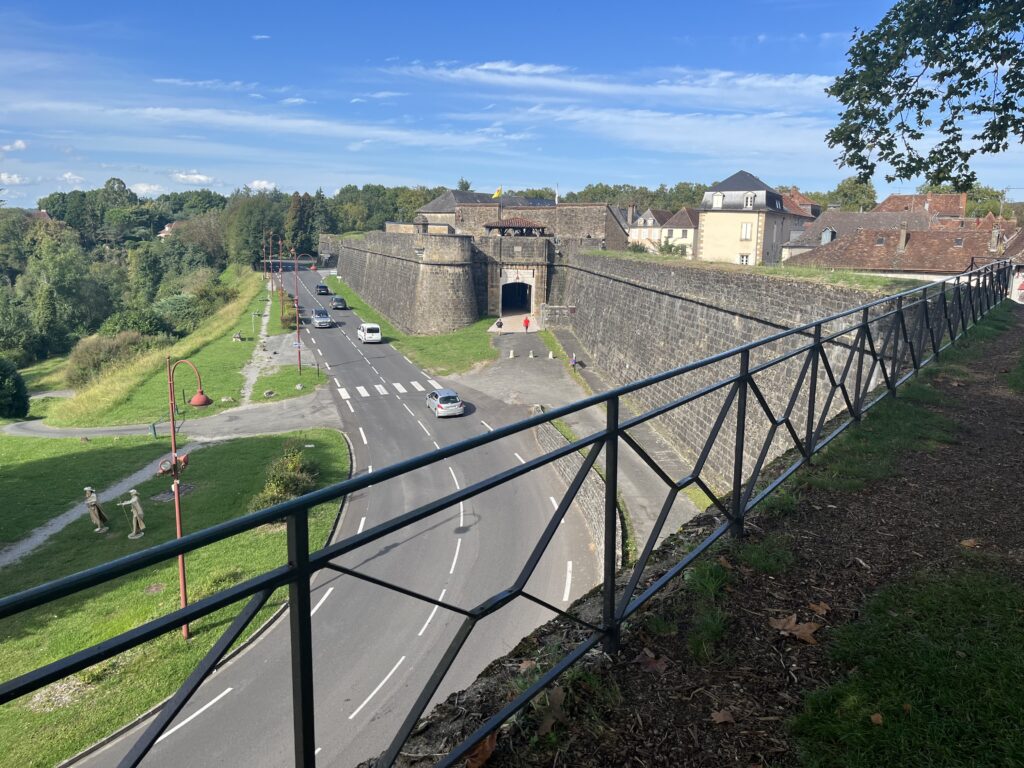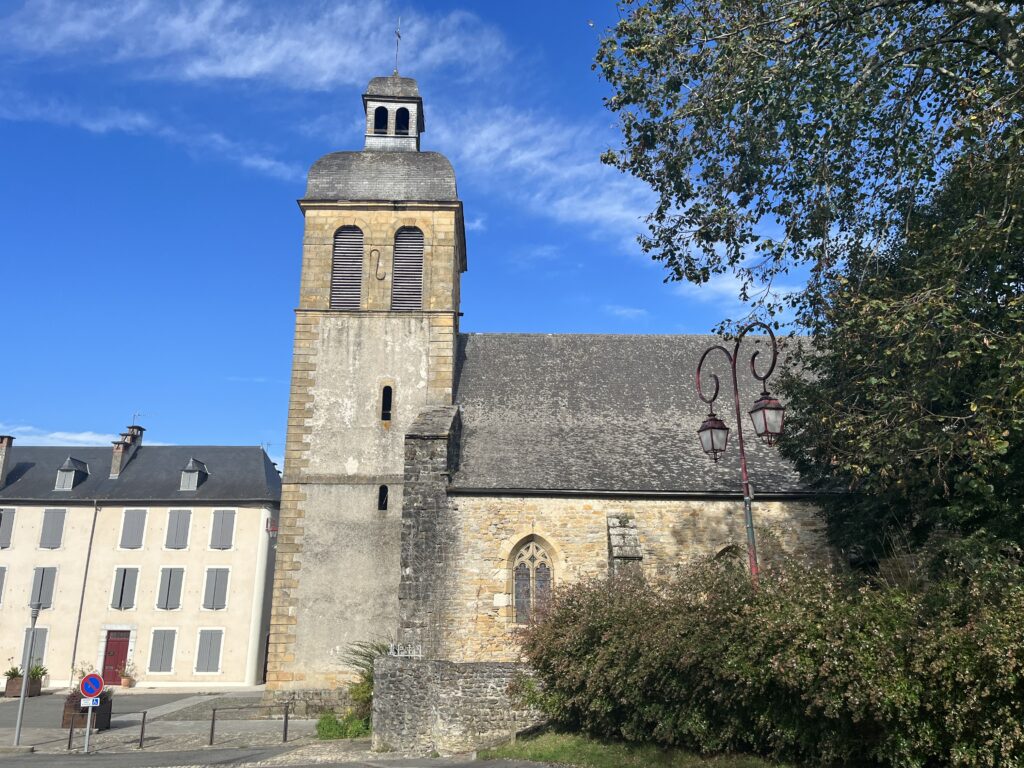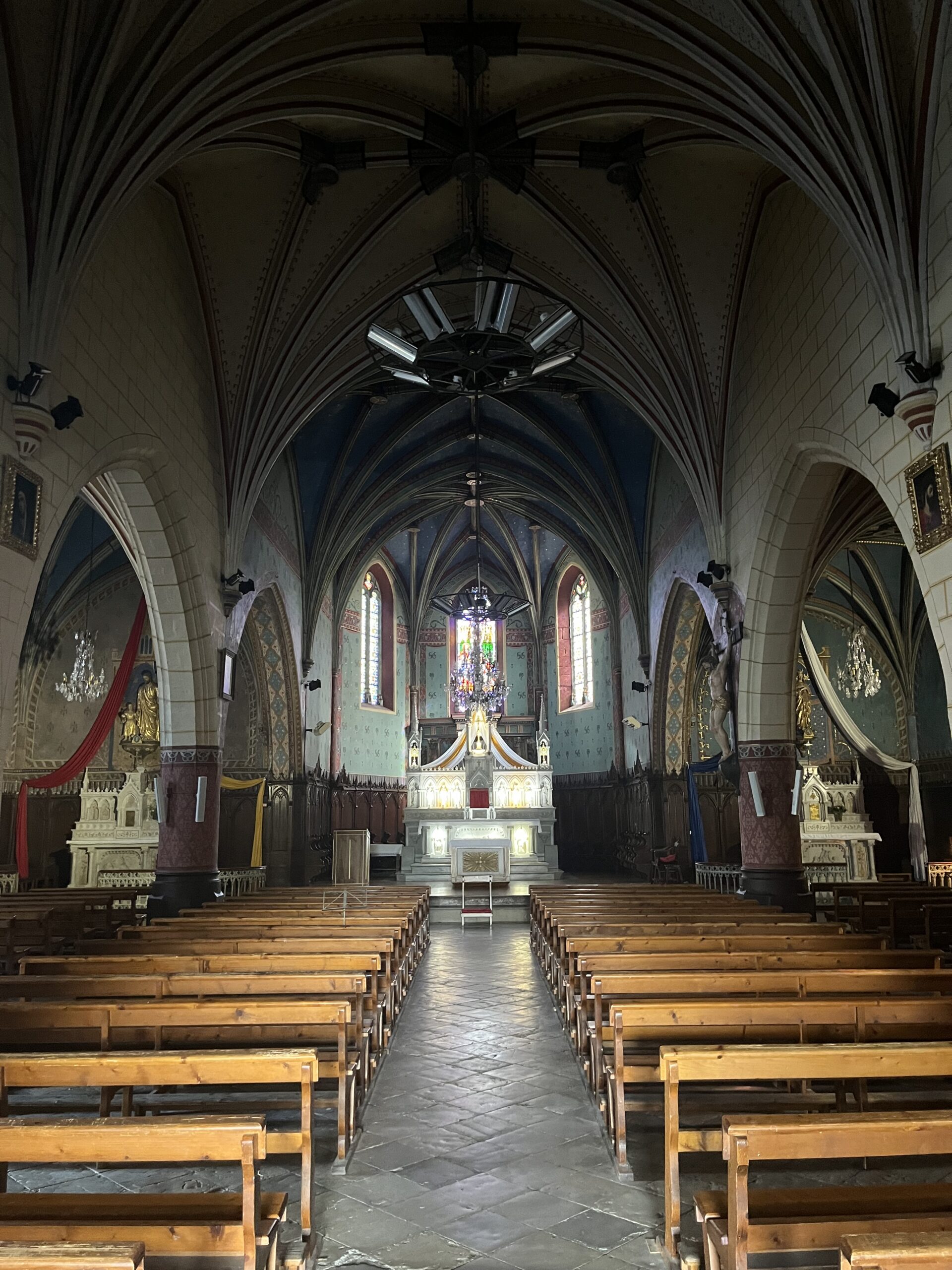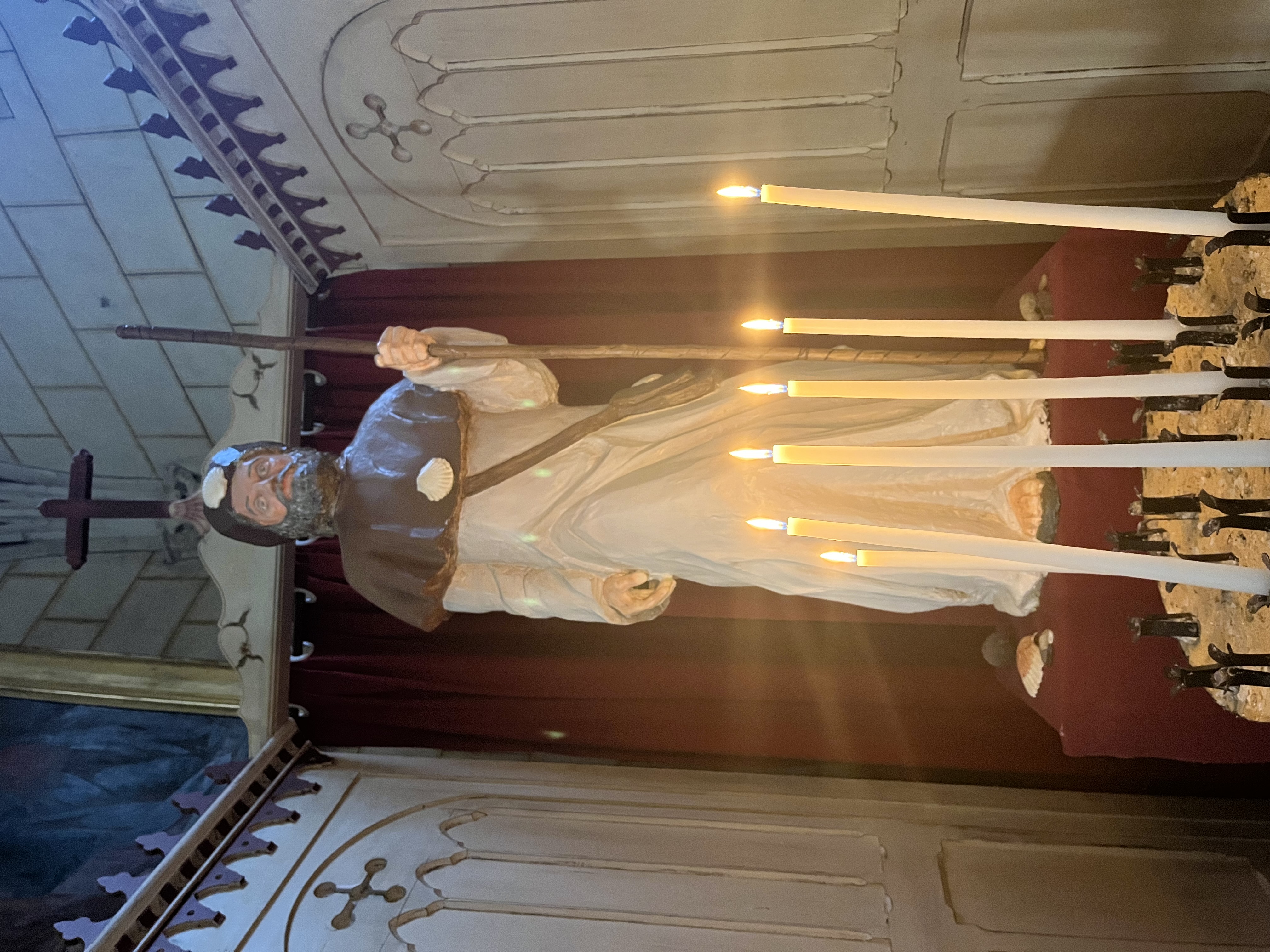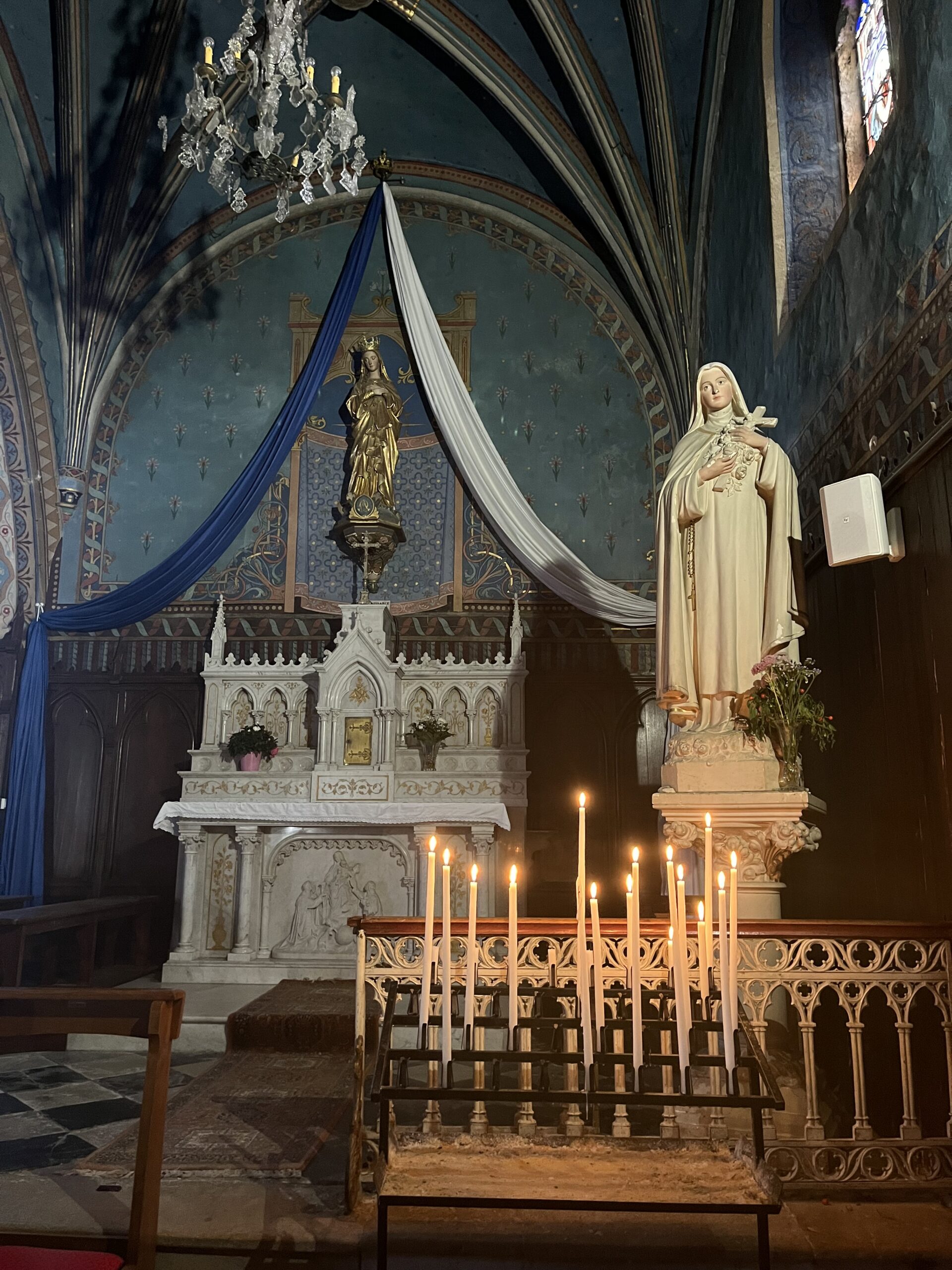Via Podiensis: Mostly Damp
It rained last night. Not hard, but pretty constant for most of the night. This, combined with the sort of general dampness of our gîte, means that not only did the clothes I washed last night not get dry, even clothes I didn’t wash at all feel vaguely damp.
I left about 6:15 this morning, which was about half an hour after I wanted to. I was trying to deal with damp clothes. The way out of town was the easiest yet, as there is really only one street. It was dark when I left, but the street lights were good. The only moment of confusion occurred when the road actually forked, but I was soon able to find the waymarking even in the dim light.
The street lights grew more infrequent, and so I was finally forced to turn on my flashlight. The houses slowly grew thinner on the ground. A great meadow yawned to my left. Eventually, the street lights ended completely.
In the east, the sky was just starting to lighten.
The road narrowed, and the pavement ended. The Camino was swallowed by trees. I pressed forward on a path now dirt and stone.
Throughout those first kilometers, my only companions were the competing cries of the rooster and the owl.
About 7:15 AM, the Camino joined a shiny new blacktop road that soon headed out into open countryside. I was afforded a magnificent view of a farming valley with the Pyrénées looming in the distance. I disturbed the early morning munching of a fawn who leapt away across the field.
I turned off my flashlight and headed down into the valley, into the cornfields.
Within just a few kilometers, I was walking through a very dispersed village. Many of the houses look like relatively new construction, although here and there you could spot a much older building. It has the look of a village, or more likely a series of farmsteads, slowly morphing into suburbia. There was no village at this location listed on any of my maps.
I entered my first (actual) village of the day, Argagnon, at about 7:45 AM. The Camino just sort of skirts the edge of the village, and I wasn’t going to take time to go into the center to see if the boulangerie was open. I did, however, stop by the village church of Saint Pierre d’Argagnon, which is also on the outskirts. It was locked.
The sky was just amazing when I arrived there, with a gorgeous sunrise to the east, and a rainbow opposite it to the west.
The Camino continued on a little dirt path next to a busy highway. Eventually, the Camino crossed the highway and then continued down next to a slightly less busy two-lane road. In rapid succession on a series of bridges, I crossed over railroad tracks, a fairly substantial river, and a large divided highway.
This brought me neatly into my second village of the day, Maslacq. The outskirts of this village are pretty sparse, lacking even the housing density of the suburbia I went through earlier. But the center is a relatively normal, if slightly rundown, southern French village with some very grand houses, mostly boarded up and for sale. If there was a village church or any shops, I did not pass them.
There was an amazing château, which reminded me of Marlinspike from the Tintin books. It appeared to be sadly abandoned.
It was now back to roadwalking in earnest, and when I finally ran out of village, the road became gravel and the scenery became cornfields.
The seemingly endless cornfields eventually ended, and the Camino climbed into the woods again, probably about 9 AM. It was damp and occasionally misty. I’m pretty sure that the clothes hanging off the back of my pack weren’t getting any drier.
Shortly after getting to the top of the hill, I was back in farm country and back to asphalt. The Pyrénées are quite close now, and rather than being a single shadow on the horizon I could see peaks and valleys and ranges within them.
Once more it was down into the valley. This is a theme that would repeat itself with only minor variations for the rest of the day. The hills were getting taller, and the valleys were getting shallower. The climbing muscles in my legs were waking back up after a slumber of a week or so.
The valleys had a beautiful sameness to them. Sheep and cattle dotted the hillsides, and stands of trees outlined large squares of pasture and cropland. Houses, and sometimes even whole villages, were randomly dabbed as if from an artist’s brush.
This particular valley culminated with a lovely little run down a forest path full of slippery, claylike mud. It was slow going.
Shortly after exiting the bog, I found a picnic table and a fountain with potable water to top off my bottles. This was second breakfast and 16 km done on the day. For the record, the clothes clipped to the outside of my pack were still damp.
The worst part of these long looping trails through the hills, is often I could see the Pyrénées behindme.
Then it was steeply uphill and then downhill on asphalt to Sauvelade. The air smelled of mint and hay and damp earth. The center of the village is the 12th century church of Saint-Jacques-le-Majeure. It is all that remains of a Benedictine (from 1286, Cistercian) monastery. It was burned by a protestant army in 1569, and seized by the French state after the revolution. The church itself is still owned by the state, although based on the Mass schedule posted outside, it is very much in use.
The church is cruciform with a main sanctuary and two side altars. The entire structure is solidly Romanesque, although the main altar and sanctuary furniture all appear to date from the 19th or 20th centuries. The side altars are Baroque. I felt a great peace in there as I prayed.
It has been a rough couple of days, and I stayed probably longer than I should have. It was after 11 AM by the time I left, and I still had 14 km and two big hills (and several smaller ones) to go today.
So it was back on the road. Asphalt, that is. And those climbs were no joke. I don’t know if these hills qualify as foothills or not, but after the first one, I wanted a nap. Halfway through the second climb, I was ready for Jesus to come get me.
I honestly don’t know how they safely drive cars down some of these roads.
All of this roadwalking has been really hard on my feet, not to mention my morale. I am seriously considering taking a rest day in Saint Jean in a couple of days, so I can tackle the mountain pass relatively fresh.
At the top of the second hill, there was a tiny village. I remember thinking that a kid with a lemonade stand could make a fortune here.
It was about 12:30 PM, the sun was out, and it was getting quite warm. Umbrella time. Hopefully, the clothes clipped to my backpack would finally dry.
The road was relatively flat after that, and I passed by an enormous duck farm before once more finding myself amongst the corn. finally, the Camino started descending again, this time through a forest.
It was nice and cool, which was fantastic, as just those few brief kilometers walking on hot asphalt really took it out of me.
At some point, there were a couple of corn patches in the woods. Just to make sure I wasn’t hallucinating this, I took a photo. Is there no place in Gascony that they won’t grow corn?
At about 1:30, I left the forest and walked directly into a suburban neighborhood. Now at least, I was walking on the sidewalk instead of the road. Still asphalt though. This was the village of Méritein.
I took a quick break to rest my feet before continuing through the village. The church was locked.
After the village, I was walking on a gravel path/sidewalk next to the road. There were cornfields, as well as scattered suburban housing. Finally, I passed through a tunnel under a busy road and emerged in the bounds of the town of Navarrenx. It was still cornfields.
In just a few hundred meters, however, I was properly in town. as in: within the ramparts of this fortified town. It was 2:30 in the afternoon.
My first priority was the tourism office to secure myself someplace to sleep tonight. This proved slightly more difficult than usual, but in the end, I was able to get into the Gîte Communaux.
After the usual pilgrim ablutions, I went out to explore the town. I started by walking the ramparts. As you might expect, they offer a commanding view of the valley surrounding the town. Their construction appears to be primarily rammed earth with exterior stone facing. I’m sure that this was the height of military technology when it was built in the 16th century.
There’s even still a cannon on one of the bastions. It’s pointed directly at the arched bridge which provides the only crossing of the river below.
I made my way over to the church of Saint-Germaine. It’s absolutely gorgeous. Just after construction was finished in 1562, the Queen of Navarre who ruled these lands declared herself a Huguenot, and this building was transformed into a protestant church.
It was not returned to the Catholic Church until 1620. It’s pretty clear to me that when that happened, the locals determined that they were going to make it the most Catholic looking Catholic Church anybody has ever seen.
The building is primarily a Gothic style, with two marble side altars in exactly the same style as the high altar. Wooden choir seats line the sanctuary.
Most unusually, there are chairs for presider, deacons, and servers at both of the side altars, which seem to indicate their continued use.
The place is marvelously appointed and immaculately clean. The parishioners clearly love this place. Pretty much the whole time I was here, there was a constant stream of town folk and pilgrims coming in and out of the place.
I prayed Vespers there for the intentions of the pilgrimage.
Afterwards, I attended the Vigil Mass there. Oh! The Mass was so beautiful! I will leave the details perhaps to a discussion with fellow liturgy geeks sometime. But suffice to say, it was beautiful, moving, holy.
Then a big dinner at an outdoor table at a place down the street from the church.
Tomorrow is, praise God, a much shorter stage than the recent days.
Date: 16 September 2023
Place: Navarrenx
Today started: Arthez-de-Béarn
Today’s Photos!

